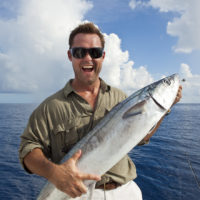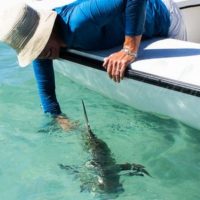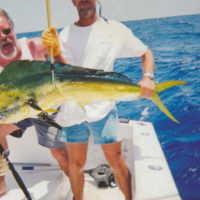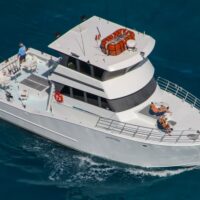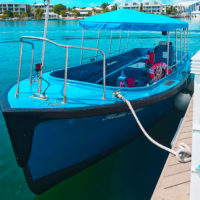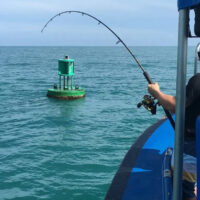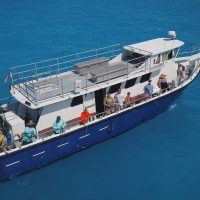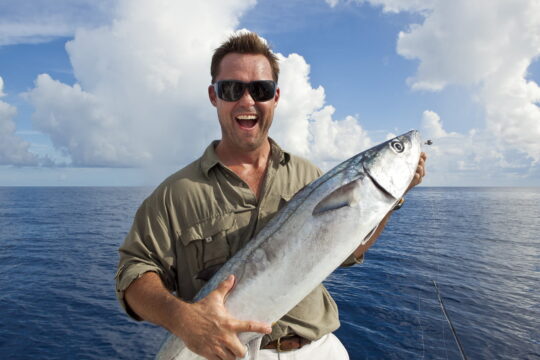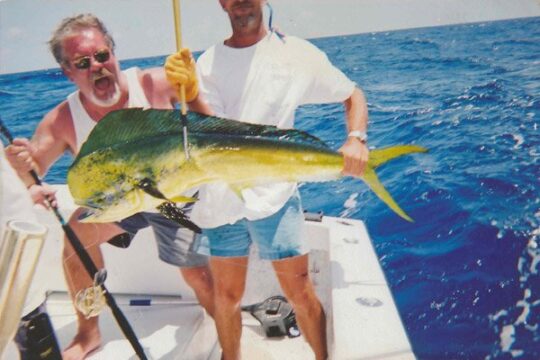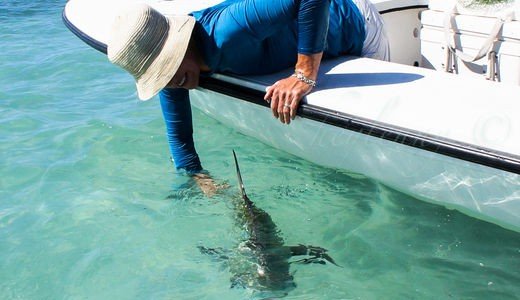Fishing for Amberjack in Key West
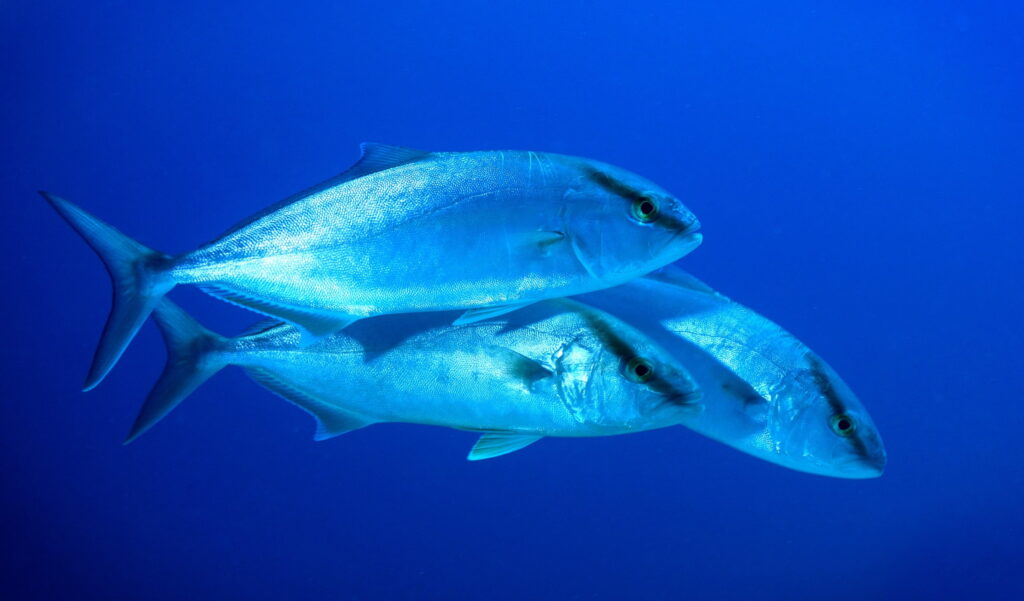
Two types of Amberjack are found in Key West waters – the Greater Amberjack (Seriola dumerili) and the Lesser Amberjack (Seriola fasciata). Greater Amberjack are by far the larger of the two and are the most commonly targeted by sportfishermen. Up to 5 feet long and nearly 200lbs, massive size combined with brutal fighting strength make the Greater Amberjack one of the most popular Key West gamefish. (Florida Record: 142lbs)
Greater Amberjack (Seriola dumerili)
Greater Amberjack are the largest of the 3 members of the Jack family (genus Carangidae), with the Alamaco Jack and the Yellowtail Jack being the other two species. The Greater Amberjack is a large, muscular fish with a deep body and deeply-forked tail. The largest fish on record weighed 178lbs, and lengths of 75” have been recorded. Around Key West, Greater Amberjacks typically run about 40” long and just under 40lbs. In contrast, the Lesser Amberjack usually runs about 10lbs and 20” long.
The Greater Amberjack’s body color varies from brownish to bluish-grey on the upper portions to silvery white on the lower sides and belly. A dark amber stripe extends from the nose over the back to the first dorsal fin; this stripe becomes more defined when the fish is excited or feeding. Another stripe runs from the upper jaw over the eye to the front of the first dorsal fin. Some fish have a light-yellow or bronze-colored stripe along the lateral line of the body. Juvenile fish have a yellowish color and 5 or 6 dark vertical bars along their sides.
The Lesser Amberjack looks much like its bigger cousin, but it has a larger eye and the body is deeper from the back to the belly. Coloration tends to be more olive green or brownish on the back, with silver sides. A dark stripe runs from behind the eye to the front of the first dorsal fin.
Greater Amberjack Habitat and Behavior
The Greater Amberjack is found in sub-tropical and tropical waters around the world from the Indian Ocean along the South African coastline, east to the Persian Gulf, to Western Australia, Southern Japan, and the Pacific Islands of Micronesia. In the western Atlantic Ocean, the fish is found around Bermuda and over to the coast of the Americas where it ranges from Brazil into the Caribbean Sea and the Gulf of Mexico to as far north as Nova Scotia.
The Greater Amberjack is an important food and recreational fish wherever it is found. As a result, it is exposed to the risk of overfishing. The NOAA Fisheries Department classifies three stocks of Greater Amberjacks near Florida: the Gulf of Mexico, South Atlantic, and Caribbean stocks. The Gulf of Mexico stock is considered to be overfished, and the Florida Fish and Wildlife Commission has established seasonal restrictions and a daily limit of 1 fish, with a minimum length of 34” to the tail fork, per person. In the Atlantic waters off the Florida Keys, where the Greater Amberjack is often found anywhere from deep reefs and wrecks to shallow inshore waters and around floating debris, the bag limit is 1 fish of at least 28” with no seasonal restrictions.
Greater Amberjack can live 17 years, and in the western Atlantic they reach reproductive maturity at 3 years of age for males and 4 years for females. Fish off Belize have been observed to form schools of about 120 fish and pair to breed mainly on full or waning moon nights in October and February. A single female can lay 18 to 59 million eggs in one spawning season. Off the Florida coast, the fish spawn over reefs and wrecks. Spawning lasts from March to June and peaks in April and May, with each female spawning once every 4 or 5 days. The larvae hatch in around 40 hours and are then pelagic for the 31-36 days it takes them to develop into juveniles.
Juvenile fish live around wrecks, reefs, and other structure where they can find shelter. They have been found far out at sea sheltering among floating weed patches and debris. Mature Greater Amberjacks may be found alone or in moderate-sized schools both near bottom structure and out in the open water column. They prefer reefs, drop-offs, deep offshore caves, seaward reefs, and large shipwrecks, where the feed on other fish, squid and octopus, crab, shrimp, and other crustaceans. The Lesser Amberjack has much the same lifestyle, but tends to be found in deeper waters of 165 to 430 feet as compared to the 40- to 240-foot depths where Greater Amberjack are commonly encountered.
Fishing for Greater Amberjack
The Greater Amberjack is often called the Reef Donkey for the extremely stubborn fight it can put up. Although the fish is sometimes taken on light tackle, particularly in shallow water, equipment in the 50- to 100lb. range is more common. Especially when fishing wrecks or reefs around Key West, where Greater Amberjacks grow to exceptionally large sizes and sometimes go over 100lbs, it is imperative that the angler be able to keep the fish from going into shelter and breaking the line.
The fish are aggressive and fearless feeders, hitting most common baitfish species including blue runners, pinfish, pigfish, grunts, cigar minnows and sand perch. Almost any large live bait or jig will work. When bait fishing, rig the weight so the bait can be kept in the middle of the water column above the reef since that is where the Amberjacks like to swim. When a feeding frenzy is triggered, the fish will come to surface and hit plugs, jigs, spoons, and other lures. One strategy is to chum with live blue runners to draw the fish up near the boat, then cast into the feeding school.
When a big Amberjack is hooked in deep water, expect a long battle and a true test of the angler’s mettle. Although Amberjacks are tasty broiled, smoked, or when used to make fish dips, the strength and endurance these powerful fish display in the fight are what makes them a favorite Key West gamefish.

